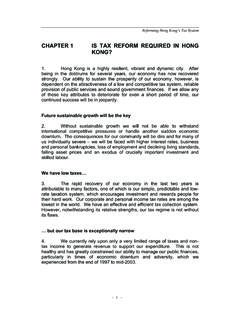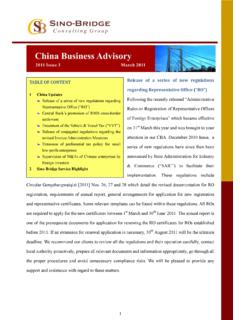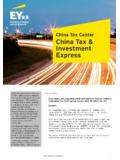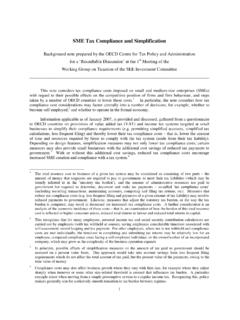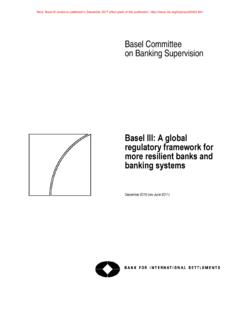Transcription of CHAPTER 5 A PROPOSED GST FRAMEWORK FOR …
1 The GST FRAMEWORK - 31 - CHAPTER 5 A PROPOSED GST FRAMEWORK FOR hong KONG 77. In proposing a suitable GST FRAMEWORK for hong Kong, we are guided by the following principles: simple and certain it should be compatible with our existing low-rate taxation system; fair and equitable it should tax the Government, business and individuals in similar ways; economically neutral it should not cause market distortion nor affect market decisions on resource allocation; efficient and effective it should minimise the administrative costs for the Government and compliance costs for business; and revenue generating it should be able to generate a steady and growing stream of income to meet public expenditure requirements.
2 What are the PROPOSED GST features? 78. A brief summary of our proposal is in Table 4. Table 4 PROPOSED features for GST in hong Kong Proposal Rationale General Features (a) Type of GST Credit-invoice based on destination principle Credit-invoice destination approach is the modern international benchmark. GST would be levied on domestic consumption, including imports, but not on exports. Export competitiveness would be maintained. The GST FRAMEWORK - 32 - Proposal Rationale General Features (b) GST rate Low and single-rate A low, single rate is considered appropriate for hong Kong.
3 This would also be consistent with the requirements of the Basic Law. (c) Registration threshold Annual turnover of $5 million and above A high registration threshold would exclude most small and medium-sized enterprises from the tax net. (d) Tax base Broad-based, with few exemptions A simple, efficient and robust tax system, with comparatively low costs of compliance for businesses. (e) Food, Health and Education No special treatment In order to minimise complexity and maintain a broad-based tax. (f) Treatment of e-business No special treatment GST would apply to e-business or electronic transactions in a similar manner to those transactions performed in the physical world. E-business is just another mode of transacting business.
4 Special Features (g) Treatment of Exports Zero rated Following the destination principle and in line with international practice, export goods and international supplies would be zero rated. This would maintain hong Kong s competitiveness and status as an international trading and logistics hub. (h) Tourist Refund Scheme (TRS) Refund of GST to be provided to tourists To retain hong Kong s appeal to tourists as a shopping paradise, we would introduce a TRS for tourists leaving at all departure points. (i) Treatment of Financial Services Mostly zero rated In the interest of maintaining hong Kong s competitiveness as a leading financial centre, we propose that most financial services be zero rated.
5 (j) Treatment of Immovable Property Non-residential: taxable Residential: exempt In line with international practice, we propose to tax non-residential property and exempt residential property (both sales and rentals). The GST FRAMEWORK - 33 - Proposal Rationale Special Features (k) Deferral Schemes for Imports Deferred GST Payment Scheme (DGPS) and Qualifying Exporters Scheme (QES) For purposes of trade facilitation and cashflow management, we propose that a DGPS and a QES be put in place to mitigate upfront GST costs on traders at the time of importation. In addition, temporary storage areas and bonded warehouses would be licensed and authorised for unloading and storage of imported goods pending GST payment.
6 (l) Treatment of Charities and Not-for-profit OrganisationsTaxable if registered We propose that all approved tax-exempt charities should have the ability to register for GST and reclaim input tax, even if they were not undertaking a commercial activity. Not-for-profit organisations would, however, only be allowed to register if they were undertaking a commercial activity. (m)Treatment of Government Only commercial and non-regulatory activities are taxable The Government would be regarded as a taxable person to enable it to reclaim input tax on its purchases. Moreover, to ensure that the Government could compete with the private sector on a level playing field, the Government s commercial and non-regulatory activities would be subject to tax.
7 (n) Transitional rules To be developed Transitional rules would be drawn up to minimise the impact of GST upon its implementation. These would be based on international practice. The GST FRAMEWORK - 34 - 79. paragraphs. General features (a) What is the type of GST being PROPOSED ? 80. hong Kong would adopt the credit-invoice, destination principle as its tax model. The operations of the GST tax credit mechanism have been explained in CHAPTER 4. A tax invoice system would be used as the basis for entitlement to reclaim GST incurred on purchases. Under the destination principle, exports would be relieved of tax and imports would be subject to tax. The credit-invoice, destination principle model for GST is the preferred international approach and would be required to maintain the competitiveness of our exports.
8 (b) What is the PROPOSED GST rate? 81. While we have no predetermined view on the GST rate, we consider that it should be set at a low level and, if introduced, should not be changed for at least five years. Our modelling indicates that each percentage point of GST, with minimal exemptions and zero-rated items, would yield approximately $6 billion in revenue a year. This would mean that the GST rate of 5% assumed in the example given in CHAPTER 4 would be capable of generating $30 billion in gross revenue. We believe that a low-rate GST would be appropriate for hong Kong and consistent with the Basic Law, which stipulates in Article 108 that: The hong Kong Special Administrative Region shall, taking the low tax policy previously pursued in hong Kong as reference, enact laws on its own concerning types of taxes, tax rates, tax reductions, allowances and exemptions, and other matters of taxation.
9 82. Based on international practice and for administrative simplicity, we do not consider it desirable to have multiple GST rates. More than one GST rate would significantly increase compliance and administrative costs for business and the Government. Internationally, some economies have more than one GST rate, but those economies that have recently implemented a GST, Singapore and Australia, have adopted a single rate. The PROPOSED features are set out in more detail in the following The GST FRAMEWORK - 35 - (c) Who would need to register? 83. The GST administration would require registration of a taxable person who conducts a taxable activity , which generates a turnover in excess of the registration threshold.
10 Please see Box 1 below for an explanation of the highlighted terms. 84. Currently, there are around 750 000 businesses on our Business Register, of which approximately only 230 000 are active. Of these, 65 000 businesses have an annual turnover of $5 million or above. We propose setting the registration threshold at this level. A $5 million registration threshold would be high by international standards, as illustrated in Table 5. Registration would be mandatory for those businesses with a turnover exceeding the $5 million threshold and would be optional for those with a turnover below the registration threshold. Table 5 GST registration thresholds of other major economies Australia Canada New Zealand Singapore United Kingdom GST Registration Threshold (HK$ equivalent*) A$50,000 ($288,500) C$30,000 ($204,600) NZ$40,000 ($200,000) SG$1 million ($4,820,000) GBP61,000 ($847,290) * The HK$ equivalent is derived from the average exchange rates of these currencies against the hong Kong dollar from January to June 2006.
